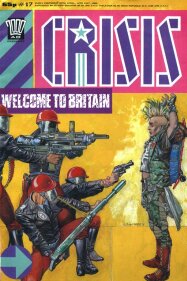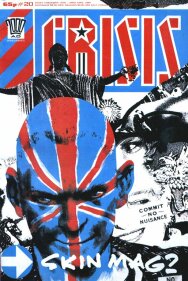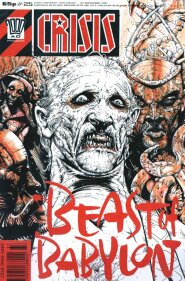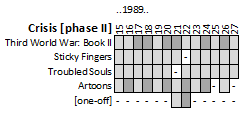| Crisis (phase I) (1988-1989) |
Crisis (phase II) (1989) |
Crisis (phase III) (1989-1990) |
Crisis (phase IV) (1990) |
Crisis (phase V) (1990-1991) |
Crisis (phase II)
Issues 15-27: 1989
 |
 |
 |
| Crisis #17 by Glenn Fabry | Crisis #20 by Brendan McCarthy | Crisis #25 by John Hicklenton |
The second phase of Crisis switches from two to three series (plus a regular surreal art slot). The first phase featured US superheroes in New Statesmen (albeit from a sci-fi foundation rather than from pure fantasy) and a near future in Third World War. The second phase moves things much closer to the present as two of the stories are contemporary (and all are now UK-set).

Third World War: Book II
The characters from the first Book return home to the UK from their corporate hoolaganism in Central America, and find themselves in a near-future Britain that's oddly prescient. Privatized police assist a state that's highly racist and cozy with corporations that run themselves like indentured labor camps. There's a sense of familiarity with today's gig economy corporate culture and stories of Amazon employees being tracked in and out of toilets. On the other hand, it harks back in time to the open racism of the Met Police in the era of the Brixton riots. Through a modern lens, it's too knowingly aggressive, as racism has become more covert in its approach - more 1984 than Lord of the Flies.
Eve finds herself involved both with Paul/Finn's militant escapades and also that of BADS, an armed black group organizing resistance against an oppressive regime. A side-plot has the policeman in charge of investigating BADS as a murderous pervert lusting after Eve.
Continues into the next phase...
Sticky Fingers
Sometimes compared to Love & Rockets, this is a contemporary piece about Weeny, a young woman who's trying to reform from a life of petty thievery and make a go of an apprenticeship as a carpenter. Two things stand in her way: her past throws up complications, and her difficulty in dealing with emotional stress (and close relationships) usually leads her to revert to past patterns of destructive behavior.
Definitely scoring points for realism, there's no easy fix for the characters' tribulations: life is complicated and people don't always make the best choices - even when they say they want to.
Sticky Fingers is brilliant and the complexity of emotional impact seen in apparently simple and trivial things throws the blunt meladrama of Third World War into sharp contrast.
This is one series and done.
Troubled Souls
In a pre-peace pact Northern Ireland, a young protestant (Tom Boyd) is intimidated into planting an IRA bomb, but then realizes that a loved one is in the area. In the aftermath, Tom struggles to come to terms not only with what he's done, but with living in such a highly sectarian region.
This manages the trick of walking a fine line through a highly charged narrative, and never lets itself get too far away from the humanity at the core of the characters. It's an incredible breakthrough piece for Garth Ennis (writer), with painted art by John McCrea.
A spin-off series starts in issue #40...
Artoons
Brendan McCarthy's surreal, often political, often obscure art pieces. As an example: there's one featuring three religious figures (from the three key Abrahamic religions) with gaping mouths all claiming to speak with the voice of God. Their mouths, though, lead through to the empty space behind them. A holy book dangles from a hook (from on high).
These come to an end in this phase.
| Crisis (phase I) (1988-1989) |
Crisis (phase II) (1989) |
Crisis (phase III) (1989-1990) |
Crisis (phase IV) (1990) |
Crisis (phase V) (1990-1991) |
